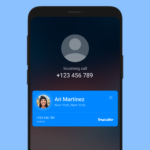What Does It Mean?
If you see a checkmark call, your phone service carrier has verified the number. This means you can trust the information on the screen and know exactly who is calling you. Such calls are reliable because they indicate that the carrier has verified them1.
This phrase is often used in business and other situations to save recipients from fraudulent calls. This verification system is not flawless, but it’s one of the best available right now. A better option would be some digital fingerprint, which could be added to all calls and checked against a database of known identities. However, that’s easier said than done1.
How Does It Work?
A verified phone call is made by a user who has already been checked. Users can identify themselves as being verified by checking their name in the settings or seeing a tick next to their profile.
The verification process is based on a technology called STIR/SHAKEN, which stands for Secure Telephony Identity Revisited and Secure Handling of Asserted information using tokens. This technology allows the caller’s carrier to authenticate the caller’s identity and send a digital signature along with the call. The recipient’s carrier can verify the signature and display a checkmark if the call is authentic.
There are different levels of attestation for verified calls, depending on how much information the caller’s carrier can provide:
Full Attestation: The caller’s carrier guarantees that the call has not been altered in any way before being sent out to the network. If you have verified calls that have been fully attested, they are considered “truthful”.
Partial Attestation: The caller’s carrier admits that the call has been altered in some way. Partial attestation means the caller’s information may not be 100% accurate.
Gateway Attestation: The caller’s carrier is not willing to fully attest to their accuracy, but they are willing to give you enough information to make an informed decision about whether or not to accept it as being true1.
Why Is It Important?
Verified calls are important for several reasons:
They help you avoid robocalls and other spam calls that can waste your time, money, and personal information. They help you identify legitimate callers like businesses, banks, government agencies, or friends and family. They help protect yourself from scams, frauds, phishing, and identity theft.
They help you improve customer service and trust with clients or customers.
How To Get Verified Calls?
Getting verified calls is essential if you want your calls to get accepted. People can block your number or refuse to divulge personal information if you’re not verified. Here’s how to get verified:
Make sure your phone carrier supports STIR/SHAKEN technology and has implemented it on their network. Make sure your phone device supports call verification display and has updated software. Make sure your phone number is registered with your name and address with your carrier. Make sure you use a secure connection when making calls, such as Wi-Fi or cellular data12. Conclusion Calls with checkmark have been verified by the carrier to ensure that the calls you receive are authentic and trustworthy. They are based on a technology called STIR/SHAKEN, which allows carriers to authenticate callers’ identities and display a checkmark if the call is verified. Verified calls can help you avoid spam calls, identify legitimate callers, protect yourself from scams, and improve your customer service.



